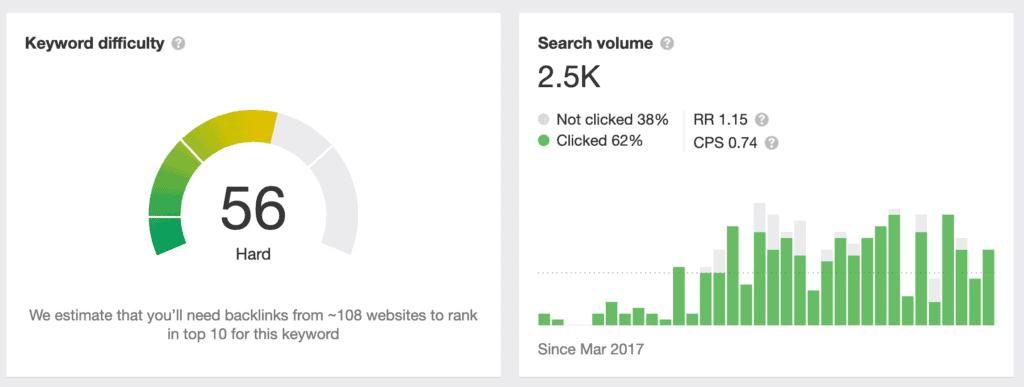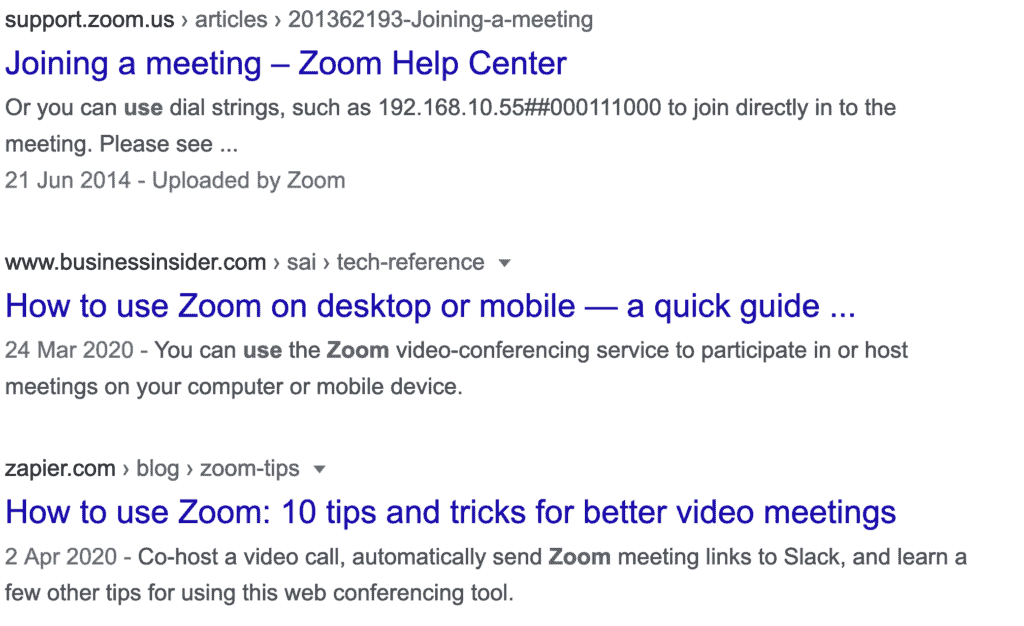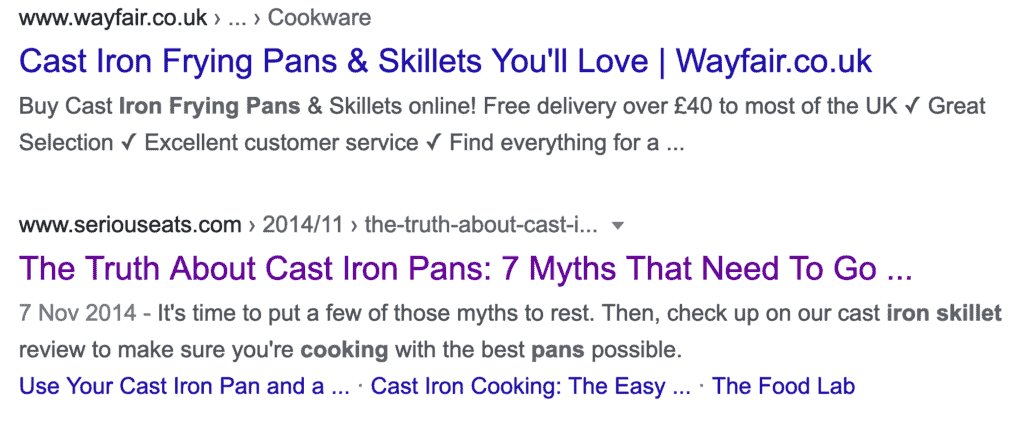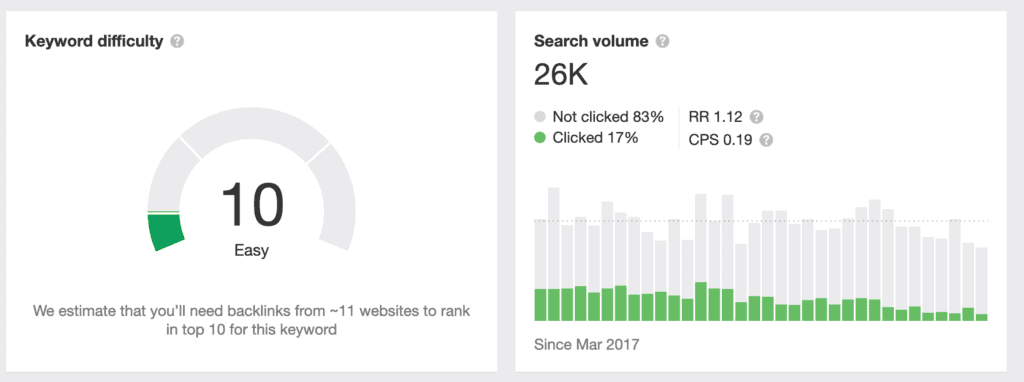Keyword difficulty or SEO difficulty is the likelihood of ranking for a keyword. And the way most bloggers estimate it is dangerous.
They use SEO tools like Ahrefs, Keysearch, or SEMrush and rely on their keyword difficulty scores to tell how easy ranking for a keyword should be.
The problem is that keyword difficulty scores are guesses and trusting them blindly is more likely to hurt you than help you rank.
This article will show you how to determine keyword difficulty so you don’t target keywords you will never rank for.
Step #1: Use the keyword difficulty score from SEO tools
The biggest advantage of keyword tools tools is their ease of use.You enter a keyword and the tool gives you a score showing how difficult ranking for this keyword should be.
This score is often from 0 (easiest) to 100 (most difficult) but the scoring system varies from tool to tool.

Ahrefs keyword difficulty score
Here are the tools I recommend:
- Ahrefs Keyword Explorer (expensive but the most comprehensive)
- Keysearch (if you are on a budget and don’t need all the bells and whistles of Ahrefs.)
- UberSuggest (I haven’t used it much, but it’s free so worth a try)
The problem is that each tool will give you a different keyword difficulty score. Sometimes, the scores are similar. Other times, they are vastly different.
For example, here are the keyword difficulty scores given by several popular SEO tools for “easy cheesecake recipe”:
- Keysearch : KD 46 (moderate)
- Ahrefs KD 34 (hard)
- SEMrush KD 88% (very hard)
Same keyword. Different keyword difficulty scores. So which one should you trust?
Unfortunately, the answer isn’t clear because different tools use different metrics to estimate keyword difficulty. For example, Ahrefs relies entirely on the number of backlinks pointing to the top pages whereas Keysearch uses backlinks as well as various on-page factors.
You also need to remember that keyword difficulty scores are guesses since keyword tools don’t have access to Google search data.
These scores are an excellent starting point, but you should always check the Search Engine Results Page (SERP) manually.
#Step #2: Look at search results
Looking at search results is often the best way to know what Google expects and better understand what it takes to rank.
Here are a few questions I ask myself when looking at the SERP:
What kind of website is ranking?
Are the websites ranking similar to you in term of traffic and authority or are the first positions dominated by big names like Amazon, BBC or Wikipedia?
The more similar the websites ranking are to your blog, the more likely you are to rank.

Is the content ranking relevant?
Sometimes Google ranks content that’s obviously a terrible match simply because there is no better option.
If you search “wrought iron frying pan”, you will see pages from BBC Good Food and Serious Eats at the top.
But these results don’t mention “wrought iron” and focus on stainless steel and cast-iron pans.

These results may be from well-known websites but they are not very relevant.
This is a great opportunity because Google wants users find what they are looking for.
If you are the only blog talking about wrought iron pans, you are likely to outrank better-known competitors because you are the only relevant option in Google’s eyes.
Other cases when you can outrank better-known competitors by being more relevant include:
- Format mismatch: the keyword mentions a specific format (MP3, PDF, video…) but the results are in another format.
- Date mismatch: The keyword mentions a date, but the top results mention another date (or no date at all).
How recent is the content?
If you Google “best VPN”, you will notice that the top ranking results have all been updated in the last few days. Ranking for this keyword will be difficult unless you update your content every week.

On the other hand, you will sometimes notice keywords with old results.
This is a sign there isn’t much competition and a great opportunity because it means a new article is likely to rank easily.
Why you should ignore keyword difficulty
Most websites recommend only targeting low difficulty keywords at the beginning, but this is terrible advice.
You are more likely to rank for easy keywords and targeting some makes sense because it will help you rank quickly.
But your goal isn’t just to rank, it’s to create helpful content for your readers.
There is often a clear corelation between keyword difficulty and popularity. Popular keywords tend to be harder to rank for because more people target them. But these topics are popular for a reason, they are the topics your readers care the most about!
Only targeting low difficulty keywords means you choose not to write about popular topics. This strategy may help you gain traffic, but it won’t help you gain a following because people are unlikely to be interested in a blog that doesn’t discus popular topics.
The keyword this article is targeting (keyword difficulty) is tough to rank for and Grow With Less is a new website with low domain authority. I know I won’t rank on the first page of Google any time soon.
Here is why I still decided to write this article:
- I know I have a unique perspective to share and this article will help Grow With Less readers.
- This unique perspective also means that this article is more likely to attract backlinks.
- SEO is not the only way to find an audience. You are reading this article after all, and I’m pretty sure you didn’t arrive via Google.
- Keyword difficulty is a guess. I often end up ranking for keywords I thought I would need years to rank for.
The 2 methods you can use to decide what keywords to target
Caring about keyword difficulty is smart, but don’t let keyword difficulty rule your content calendar.
My advice?
Start by looking for unicorn keywords (low difficulty, high volume.) Ranking for these keywords is easy and will bring you lots of traffic.
A good way to find unicorn keywords is to think about specific questions people ask about topics in your niche. For example:
- How to make black garlic
- How to disable javascript in tor
- How to garden in sims 4

If you can’t find any (will be the case in popular niches), choose one of the following approaches:
The Slow but Steady
Write about the most popular topics (high volume, high difficulty keywords) but try to incorporate low-competition keywords in the article. This works best for authority sites who are in it for the long run.
Ranking for “best face cream” is tough so you won’t rank right away but you could rank for other keywords such as:
- Best face cream with prickly pear oil
- Best face cream without parabens
- Best almond face creams
With the Slow but Steady, your goal is to have one main keyword (the topic of your article) as well as dozens of smaller keywords (the subsections of your article.)
The Fast and Furious
Target low competition low volume keywords to quickly rank and get traffic.
This works well if your goal is to make a quick buck with ads or affiliate sales but you will struggle to create an engaged audience because people won’t enjoy your content if you only write about unpopular topics.
That’s why I recommend following the slow but steady method. You won’t rank right away but when you do, you will rank for keywords worth ranking for.
